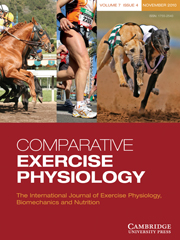Article contents
A comparative study of interval and continuous incremental training in Thoroughbreds
Published online by Cambridge University Press: 19 October 2009
Abstract
Few equine studies exist comparing the effects of different forms of training. This study tested the following hypothesis: interval training (IT) results in similar or better fitness parameters in Thoroughbreds when compared to continuous incremental training (CT) of the same workload with fewer galloping strides. Two groups of five horses underwent 6 weeks of IT or CT. Fitness levels were established before and following training. Both groups showed significant increases in VO2max (P < 0.05), lactate threshold (P < 0.05), work rate corresponding to 100% VO2max (P < 0.05) and work to fatigue during an incremental and sprint exercise test (P < 0.05). The interval-trained group had a significant increase in peak lactate values (P < 0.05) and a significant decrease in body weight (P < 0.05). The increase in VO2max of the interval group was greater than the increase in VO2max of the continuous incremental group (P = 0.10), increasing 27.38 ± 8.44 and 14.64 ± 2.66%, respectively. The interval group took significantly fewer galloping strides than the continuous incremental group for all weeks of training (P < 0.05). It is considered that supramaximal IT improves equine fitness as well as CT of the same workload with fewer galloping strides.
Information
- Type
- Research Paper
- Information
- Copyright
- Copyright © Cambridge University Press 2009
References
- 5
- Cited by

